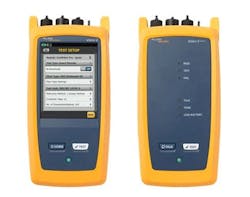A recent Cabling, Installation, & Maintenance article discussed devices that help test fiber in the field. Both optical loss test set (OLTS) and optical time domain reflectometer (OTDR) are utilized in the field, however, it is far more common for an OLTS to be used than an OTDR. This is simply due to the fact that OLTS perform Tier 1 tests which are necessary when testing versus OTDRs which perform Tier 2 tests and are not always required. On top of this, an OLTS is typically used before an OTDR as a Tier 1 test must be completed before a Tier 2 test. Tier 1 tests measure loss, length, and polarity and a technician can use an OLTS to perform this test.
What is an OLTS used for?
Per Fluke Networks, “An OLTS provides the most accurate insertion loss measurement on a link by using a light source on one end and a power meter at the other to measure exactly how much light is coming out at the opposite end. It is required for fiber testing per industry standards. Both TIA and ISO standards use the term ‘Tier 1’ to describe testing with an OLTS.”
By testing a fiber optic network with an OLTS, technicians can determine the overall performance, including the loss at joints, connectors, and splices, and also look at the fiber quality itself. An OLTS test can help evaluate the efficiency of the network and identify possible issues that may need to be addressed.
OLTS testing
The OLTS test is performed using a light source which makes a continuous wave at certain wavelengths connected to one end of the fiber. On the opposite end of the fiber link is a power meter with a photo detector which measures optical power at the exact wavelengths made by the light source. By working simultaneously, the total amount of light lost is determined.
The Tier 1 fiber optic testing industry standards of TIA 568.3 D and ISO/IEC 14763-3 state specific insertion loss limits for particular fiber applications. So, to determine whether a test passes when a test is conducted with an OLTS, the loss measured is compared to the insertion loss limits set within these standards for that specific fiber application.
The Fluke Networks article points out that a light source/power meter (LSPM) can also accurately measure loss per industry standards. However, it lacks main OLTS features that make testing easier, like duplex testing, preloading of loss limits, hands-free bidirectional testing, length measurement as well as other features. Length measurement is a particularly important feature of an OLTS because application limits are a combination of length and a loss budget.
Industry use and applications
OLTS is used in a variety of industries for different applications that use fiber networks. Some of the most well-known industries that use OLTS testing are the telecommunications and data center industries. In telecom, optical fiber infrastructure supports data, voice, and video transmission, and an OLTS is utilized to test and maintain that infrastructure. In data centers, high-speed data transfer and connectivity are imperative, and an OLTS is an important tool used to ensure fiber links are functioning well. OLTS is also used by enterprise networks and in industrial and research applications. OLTS is used by organizations and businesses that have extensive optical fiber infrastructure to monitor network performance and make sure that service delivery is uninterrupted. For industrial and research applications that use fiber optics, OLTS can be used in facilities and settings for a variety of experiments and processes.
OLTS advantages and possible challenges
As a C&C Technology Group article states, the main benefit of utilizing an OLTS is that it can accurately measure a fiber link’s total loss. As previously mentioned, there are industry standards for specific applications regarding link loss, and it is important for a technician to be able to ensure that the link meets those loss requirements. An OLTS can also measure length and optical return loss through testing the fiber link’s continuity. This can aid technicians in identifying possible issues that could affect the network’s overall performance.
One feature of an OLTS is an advantage, but can also be seen as a challenge, is that they are dual-ended. Two technicians are required to perform the test which can be difficult for companies or organizations that have limited resources, however, the benefit outweighs this challenge because having the measurement taken from both ends of the fiber link leads to more efficient and accurate testing. As mentioned earlier, an OLTS is used for Tier 1 testing and is made to test the total loss on a fiber link. However, it cannot detect and locate specific faults or events in the fiber cable. This is when Tier 2 testing would come into play, and using an OTDR would be used to note the exact location of any events or faults that may be affecting the link.
About the Author
Serena Aburahma
Associate Editor
Serena Aburahma is an editor and writer for CI&M, with several years of experience in writing, editing, and SEO. Serena has pitched and created content for various industries, including technology, video games, insurance, cars, pop culture, and more. She has also produced content for and managed CI&M's various social media accounts and is always looking for fresh and exciting ways to grow and engage with audiences.
Much like the content Serena has written about, her interests vary as well, including writing poetry and stories, meandering in nature, playing video games, traveling, and reading.

